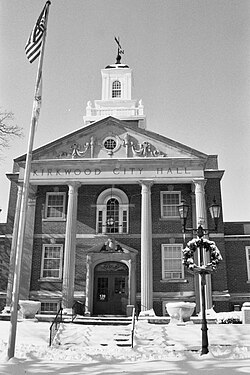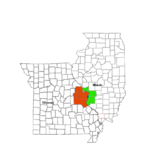Kirkwood, Missouri
Kirkwood, Missouri | |
|---|---|
 Kirkwood City Hall | |
 Location of Kirkwood, Missouri | |
 U.S. Census Map | |
| Country | United States |
| State | Missouri |
| County | St. Louis |
| Government | |
| • Mayor | Arthur J. McDonnell |
| Area | |
| • Total | 9.3 sq mi (24.0 km2) |
| • Land | 9.2 sq mi (23.9 km2) |
| • Water | 0.0 sq mi (0.1 km2) |
| Elevation | 659 ft (201 m) |
| Population (2000) | |
| • Total | 27,324 |
| • Density | 2,961.3/sq mi (1,143.4/km2) |
| Time zone | UTC-6 (Central (CST)) |
| • Summer (DST) | UTC-5 (CDT) |
| FIPS code | 29-39044Template:GR |
| GNIS feature ID | 0756252Template:GR |
| Website | www.kirkwoodmo.org |
Kirkwood is an inner-ring suburb of St. Louis, located in St. Louis County, Missouri. As of 2006, the city population was 26,936[1]. The city was founded in 1853 and is named after James Pugh Kirkwood, builder of the Pacific Railroad through that town. It was the first planned suburb located west of the Mississippi River.[2][3]
The Kirkwood Pioneers and Webster Groves Statesmen alternate as hosts of the Turkey Day game, the longest-running football high school rivalry west of the Mississippi. Held annually, Thanksgiving Day 2007 marked the 100th anniversary of the first match.[4]
History
Plans for a new community close to St. Louis began following the St. Louis Fire (1849) and the 1849 cholera outbreak that had killed a tenth of the residents of downtown St. Louis.
Hiram W. Leffingwell and Richard Smith Elliott bought land 14 miles from downtown in 1850 at about the same time James P. Kirkwood was laying out a route for the Pacific Railroad. When the railroad reached the community in 1853 they sold lots for the Kirkwood Association. Other Leffingwell developments were to include the construction of Grand Avenue and the establishment of Forest Park (St. Louis).[5]
The original town plat including quarter section blocks and families could be a block estate of five acres. Deed restrictions prohibited industrial development.
The train station of Richardsonian Romanesque style was built in 1893. It is now on the National Register of Historic Places and is a symbol of the town. It is the only stop on Amtrak in the Missouri metropolitan area outside of St. Louis.
In 1895 the Meramec Highlands resort on the bluffs above the Meramec River.
Among the five buildings on the National Register of Historic Places is a Frank Lloyd Wright house in Ebsworth Park Foundation.
However, Kirkwood has been the site of two sensational crimes in less than 13 months throughout 2007 and 2008.
On January 12, 2007, Michael J. Devlin was arrested for abducting 13-year-old William "Ben" Ownby. Police investigating the case discovered Shawn Hornbeck living at his house. Hornbeck was 11 when he was missing in 2002 and the Shawn Hornbeck Foundation had been set up to find him.
On February 7, 2008 a gunman opened fire inside a Kirkwood city council session, killing five persons: Council Member Connie Karr, Council Member Michael H. T. Lynch, Public Works Director Kenneth Yost, and two police officers, Sgt. William Biggs and Officer Tom Ballman. Two others, Kirkwood mayor Mike Swoboda and Suburban Journals reporter Todd Smith, were wounded. The gunman, Kirkwood resident Charles "Cookie" Lee Thornton, was shot and killed by police. Swoboda died of complications from that shooting on September 6, 2008.
Geography
Kirkwood is located at 38°34′50″N 90°24′51″W / 38.58056°N 90.41417°WInvalid arguments have been passed to the {{#coordinates:}} function (38.580652, -90.414289)Template:GR.
According to the United States Census Bureau, the city has a total area of 9.3 square miles (24.0 km²), of which, 9.2 square miles (23.9 km²) of it is land and 0.1 square miles (0.1 km²) of it (0.54%) is water.
Demographics
As of the censusTemplate:GR of 2000, there were 27,324 people, 11,763 households, and 7,257 families residing in the city. The population density was 2,961.3 people per square mile (1,143.0/km²). There were 12,306 housing units at an average density of 1,333.7/sq mi (514.8/km²). The racial makeup of the city was 90.76% White, 7.07% African American, 0.11% Native American, 0.81% Asian, 0.04% Pacific Islander, 0.27% from other races, and 0.94% from two or more races. Hispanic or Latino of any race were 1.09% of the population.
There are 11,763.5 households out of which 28.0% had children under the age of 18 living with them, 50.5% were married couples living together, 9.0% had a female householder with no husband present, and 38.3% were non-families. 33.5% of all households were made up of individuals and 14.9% had someone living alone who was 65 years of age or older. The average household size was 2.29 and the average family size was 2.98.
In the city the population was spread out with 23.4% under the age of 18, 5.9% from 18 to 24, 27.6% from 25 to 44, 24.9% from 45 to 64, and 18.2% who were 65 years of age or older. The median age was 41 years. For every 100 females there were 84.1 males. For every 100 females age 18 and over, there were 79.4 males. The median income for a household in the city was $55,122, and the median income for a family was $72,830. Males had a median income of $51,515 versus $36,235 for females. The per capita income for the city was $32,012. About 2.8% of families and 4.6% of the population were below the poverty line, including 6.1% of those under age 18 and 3.6% of those age 65 or over.
Transportation
Notable residents
- Scott Bakula, actor
- David Sanborn, saxophonist
- Ken Flach, Wimbledon doubles champion
- Lyle Waggoner, actor - Carol Burnett show
- John McDaniel, pianist, Rosie O'Donnell sidekick
- Josephine Johnson, Pulitzer prize-winning author, was born in Kirkwood on 20 June 1910
- Marianne Moore, modernist poet
- Ridley Pearson, novelist
- Mike Swoboda, mayor
- Jeremy Maclin, college football player for Missouri
- Al Smith, baseball player
- David Lee, basketball player
- Trent Green, Quarterback for the St. Louis Rams
- Dorsey Schroeder, race car driver
- David Frisch, football player
References
- ^ http://factfinder.census.gov/servlet/GCTTable?_bm=y&-geo_id=04000US29&-_box_head_nbr=GCT-T1-R&-ds_name=PEP_2006_EST&-_lang=en&-format=ST-9S&-_sse=on United States Census Estimates 2006
- ^ http://www.explorestlouis.com/newsReleases/neighborhoods.asp?NrType=2
- ^ The City Of Kirkwood - History
- ^ Turkey Day - Turkey Day
- ^ Kirkwood Neighborhood - St. Louis Convention and Visitors Center
Joey James- red hair


